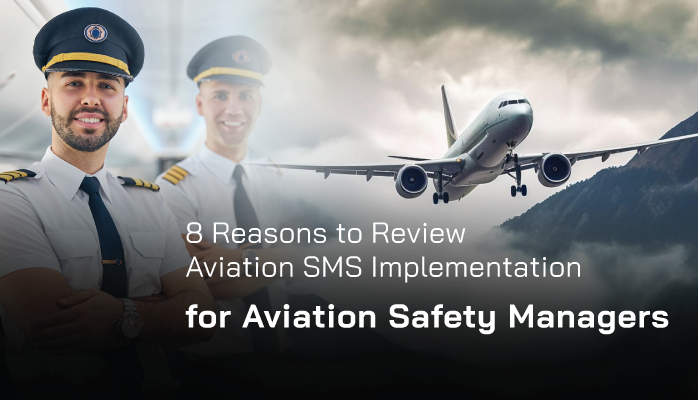Reasons to Review Aviation SMS Implementation

Aviation safety managers operate in a high-stakes environment where the margin for error is slim.
A robust Safety Management System (SMS) is the backbone for ensuring operational safety, regulatory compliance, and risk mitigation. However, an SMS is not a "set it and forget it" solution. Regular reviews and updates are critical to maintaining its effectiveness.
This article explores the key reasons why aviation safety managers should prioritize reviewing their SMS implementation, offering actionable insights to enhance safety and operational efficiency.
1. Evolving Regulatory Requirements
Aviation is one of the most heavily regulated industries globally, with standards set by bodies like the International Civil Aviation Organization (ICAO), Federal Aviation Administration (FAA), and European Union Aviation Safety Agency (EASA). These organizations frequently update their guidelines to address emerging risks, technological advancements, and operational challenges.
For instance, ICAO’s Annex 19, which outlines SMS requirements, is periodically revised to incorporate lessons learned from global aviation incidents. A static SMS may no longer align with these updates, exposing organizations to non-compliance risks. Regular SMS reviews ensure that your processes, documentation, and reporting mechanisms meet the latest regulatory standards, avoiding costly penalties and reputational damage.
Actionable Tip: Schedule quarterly audits to cross-reference your aviation SMS against the latest ICAO, FAA, or EASA guidelines. Use compliance management software to track regulatory changes in real-time.
2. Emerging Safety Risks and Threats
The aviation landscape is constantly evolving, with new risks such as cybersecurity threats, unmanned aerial systems (UAS), and climate-related challenges (e.g., extreme weather). An outdated SMS may not adequately address these emerging hazards, leaving your organization vulnerable.
For example, the rise of drone operations near airports has introduced new collision risks. A proactive SMS review can help safety managers integrate risk assessments and mitigation strategies for such threats. Similarly, cybersecurity breaches targeting air traffic control systems or onboard avionics require updated safety protocols.
Actionable Tip: Conduct a gap analysis during SMS reviews to identify unaddressed risks. Engage frontline staff and data analysts to pinpoint emerging hazards specific to your operations.
Related Aviation SMS Gap Analysis Articles
- SMS First Steps - Gap Analysis
- What Is a Gap Analysis in Aviation SMS
- 4 Best Aviation SMS Gap Analysis Strategies for SMS Implementations
3. Technological Advancements
Aviation technology is advancing rapidly, from NextGen air traffic control systems to predictive maintenance tools powered by artificial intelligence (AI). These innovations offer opportunities to enhance safety but also require SMS adjustments to integrate them effectively.
For instance, AI-driven analytics can identify patterns in maintenance data, predicting potential equipment failures before they occur. However, without an updated aviation SMS, your organization may lack the processes to act on these insights. Reviewing your SMS ensures that new technologies are seamlessly incorporated into safety protocols, maximizing their benefits.
Actionable Tip: Collaborate with IT and engineering teams during SMS reviews to assess how new tools can enhance safety reporting and risk management workflows. Update training programs to ensure staff are proficient in using these technologies.
4. Organizational Changes
Airlines, airports, and maintenance organizations frequently undergo structural changes, such as mergers, expansions, or leadership transitions. These changes can disrupt SMS implementation, leading to inconsistencies in safety practices.
For example, a merger may introduce new aircraft types or operational procedures that your current SMS doesn’t cover. Similarly, staff turnover can result in knowledge gaps if safety training isn’t updated. Regular SMS reviews help safety managers align the system with organizational changes, ensuring continuity and consistency.
Actionable Tip: After any major organizational change, conduct a comprehensive SMS review. Update hazard risk registers, safety policies, and training materials to reflect the new structure.
5. Incident and Near-Miss Learnings

Every incident or near-miss provides valuable lessons for improving safety. However, without a formal review process, these insights may not be fully integrated into your aviation SMS. For instance, a runway incursion incident might reveal deficiencies in communication protocols or training, which an SMS review can address.
Data from the Aviation Safety Reporting System (ASRS) shows that near-misses often highlight systemic issues that go unnoticed until a review is conducted. By analyzing incident reports and safety data during SMS reviews, safety managers can identify trends and implement corrective actions.
Actionable Tip: Use safety data analytics tools to aggregate and analyze incident reports. Incorporate findings into SMS updates, focusing on root cause analysis and preventive measures.
Related Aviation SMS Articles About Root Causes
- Proactive Risk Management: What Root Causes Say About Management
- How to Conduct Root Cause Analysis in Aviation SMS
- Is Root Cause Analysis Proactive or Reactive?
6. Employee Engagement and Safety Culture
A strong safety culture is essential for aviation SMS success, but it requires ongoing reinforcement. Employees may become disengaged if they perceive the SMS as outdated or irrelevant. Regular reviews provide an opportunity to solicit feedback from frontline staff, fostering a sense of ownership in safety processes.
For example, a review might reveal that hazard reporting forms are too complex, discouraging employees from submitting reports. Simplifying these forms can boost participation and strengthen the safety culture.
Actionable Tip: During SMS reviews, conduct anonymous surveys to gauge employee perceptions of safety processes. Use the feedback to streamline reporting and enhance engagement.
7. Cost Efficiency and Resource Optimization
An ineffective SMS can lead to inefficiencies, such as redundant processes or misallocated resources. For instance, if your SMS requires excessive paperwork for low-risk activities, it may divert resources from critical safety tasks. Reviewing your SMS helps identify areas for streamlining, reducing costs without compromising safety.
Additionally, a well-maintained SMS can lower insurance premiums by demonstrating a commitment to risk management. Insurers often reward organizations with robust safety systems, providing a financial incentive for regular reviews.
Actionable Tip: Perform a cost-benefit analysis during SMS reviews to identify inefficiencies. Prioritize digital tools, such as SMS software, to automate repetitive tasks and reduce administrative burdens.
8. Benchmarking Against Industry Best Practices
The aviation industry is dynamic, with leading organizations continually refining their safety practices. By reviewing your SMS, you can benchmark it against industry best practices, ensuring your organization remains competitive.
For example, SMS Pro offers integrated predictive analytics and real-time monitoring into their aviation SMS software, setting a high standard for safety management. Regular reviews allow you to adopt similar innovations, keeping your SMS at the forefront of industry trends.
Actionable Tip: Attend industry conferences, such as the Aviation Safety Summit, to learn about best practices. Incorporate relevant strategies into your SMS during reviews.
Conclusion
Reviewing your aviation SMS implementation is not just a regulatory requirement—it’s a strategic necessity.
By addressing evolving regulations, emerging risks, technological advancements, and organizational changes, safety managers can ensure their SMS remains effective and relevant. Moreover, regular reviews foster a strong safety culture, optimize resources, and position your organization as a leader in aviation safety.
To get started, schedule your next SMS review and involve key stakeholders, from frontline staff to senior leadership. Use data-driven insights and industry benchmarks to guide your updates. A proactive approach to SMS reviews will not only enhance safety but also build trust with regulators, employees, and passengers.
Do you need tools to manage and document your next aviation SMS review? Contact us today.








